Potential Energy Calculator
Calculate Potential Energy, Mass, Height, or Gravity with different units.
Choose Calculation Type
Our potential energy calculator simplifies the calculation process, providing quick and accurate results without the need for complex formulas or manual calculations.
Whether you’re a student, scientist, or engineer, using this potential energy calculator can help you get your calculations easily. From lifting objects to analyzing gravitational forces, potential energy plays a central role, and our calculator provides a reliable solution to compute it with ease.
Potential energy is a fundamental concept in physics and engineering, often defined as the energy an object holds or owns due to its position, state, height, or configuration.
This concept is crucial not only in scientific fields but also in practical applications, like calculating the energy requirements for machinery or understanding the dynamics of moving objects.
What Actually is Potential Energy?
Potential energy is the energy stored within an object due to its position, arrangement, height, or state. This energy is “potential” because it is not actively in motion; instead, it has the potential to become kinetic or active under the right conditions.
In physics, potential energy is the energy of an object or system due to the body’s position relative to other objects, or the configuration of its particles. The energy is equal to the work done against any restoring forces, such as gravity or those in a spring.
Definition Of Potential Energy (Wikipedia)
Objects gain potential energy when influenced by forces such as gravity, elasticity, or chemical composition. For example, A rock held above the ground has gravitational potential energy due to its position in the earth’s gravitational field.
Types Of Potential Energy
There are different types of potential energy depending on the force involved.
- Gravitational potential energy is due to the height of an object. You can find it using our Gravitational Potential Energy Calculator.
- Elastic potential energy is associated with stretched or compressed materials like springs or rubber bands. You can calculate it using our Elastic Potential Energy Calculator.
- Chemical potential energy is stored in the bonds of atoms and molecules, which is released during chemical reactions.
- Electrical Potential Energy is the energy stored in electric charges due to their positions in an electric field. You can also find it by using our Electric Potential Energy Calculator.
By using a potential energy calculator, you can quickly determine the amount of potential energy in a given scenario, simplifying the learning and application of this concept. This tool can be particularly helpful for students and professionals who need to calculate potential energy across various physics-related fields.
Potential Energy (P.E) Formula
The formula for calculating potential energy primarily involves gravitational force. The most commonly used formula is:
P.E = m × g × h
Where:
- P.E = Potential Energy (in joules, J)
- m = Mass of the object (in kilograms, kg)
- g = Gravitational acceleration (9.81 m/s² on Earth)
- h = Height of the object from the reference point (in meters, m)
For other types of potential energy, such as elastic potential energy, different formulas are used, but they also incorporate the object’s properties and the force exerted.
Knowing this formula can assist you in performing manual calculations for gravitational potential energy. However, with the potential energy calculator, these calculations become swift and straightforward, providing immediate results without the risk of manual errors.
How to Use the Potential Energy Calculator Correctly?
Here’s a step-by-step guide to using the Potential Energy Calculator correctly:
1. Choose P.E. from the Calculation Type
On the top of the Potential Energy Calculator, there is a dropdown to choose which quantity you want to measure. Whether you want to measure P.E., Mass, Height, or Gravity, you can choose any one of these.
To measure Potential Energy you have to choose Potential Energy from the dropdown as shown in the image.
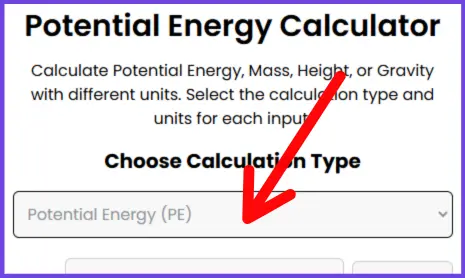
2. Enter The Mass (m)
Now it’s turn to enter the correct value of mass in the Potential Energy Calculator. With the field of mass, there is a dropdown of units for mass as shown in the image.
You must have to choose your desired unit in which mass of the object is measured. You can put mass value in these units: kg, g, lb, oz, ton. Make sure the value of mass is correct.
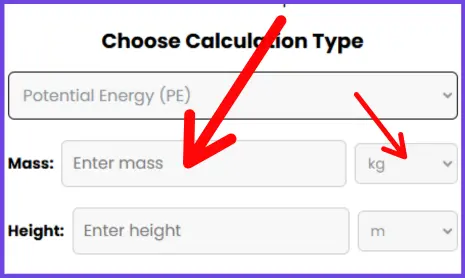
3. Enter The Height (h)
After entering mass in its desired field, Now you have to enter the correct value of height in the next field shown in the image below. Over there, there is also a dropdown for the units of height you have to choose.
You can input height in these units: m, cm, mm, ft, in. Make sure the value of height is correct and you have also chosen the correct unit for height from the dropdown.
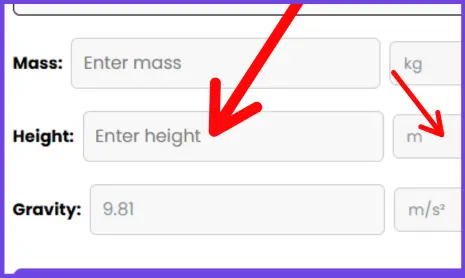
4. Confirm Gravitational Constant/Gravity (g)
At the end, there is a field for Gravity, which is also known as the Gravitational Constant (g). It is already filled as 9.81 m/s² as this is the value of gravity on the surface of Earth.
You may change if you are finding Potential Energy in other conditions or other place than Earth. With the field of Gravity, there is also a dropdown for units of Gravity. You can use these units for Gravity: m/s², ft/s², cm/s².
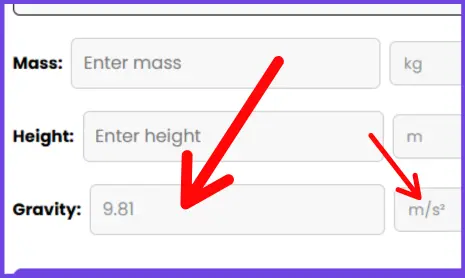
5. Calculate The Result
After entering all the values in their desired fields, you have to press the Calculate button (in purple colour) to calculate the final value of Potential Energy as shown in the image below.
The final answer of Potential Energy will appear in multiple units like J, kJ, ft-lb, and cal. So this is all on how to use the Potential Energy Calculator.
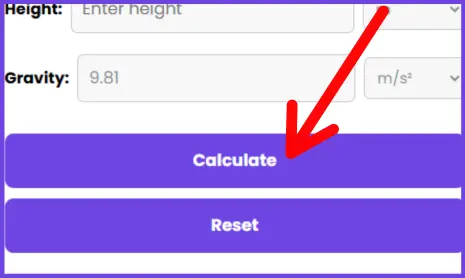
6. Reset The Tool For the Next Calculation
After completing one calculation, Press the Reset button to refresh the tool for the next calculation as shown in the image. You can measure Potential Energy, Mass, Height and Gravity using this tool.
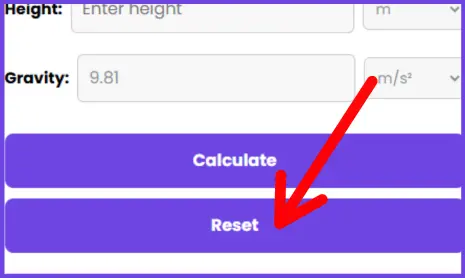
Potential Energy (P.E) Units
Potential energy is measured in joules (J), the standard unit for energy in the International System of Units (SI). However, in certain fields, other units are also used, depending on the context or scale of measurement. Here’s a table summarizing the common units for potential energy and their equivalencies.
| Unit | Abbreviation | Description |
|---|---|---|
| Joule | J | The SI unit for energy. 1 Joule = 1 kg·m²/s² |
| Kilojoule | kJ | 1 Kilojoule = 1000 Joules |
| Megajoule | MJ | 1 Megajoule = 1,000,000 Joules |
| Electron Volt | eV | Common in atomic and particle physics. |
| Foot-pound | ft·lb | Often used in engineering and mechanics |
| Calorie | cal | Commonly used in chemistry and food energy |
| Kilowatt-hour | kWh | Used in electrical energy (1 kWh = 3.6 MJ) |
Other Functions Of Potential Energy Calculator
You can use this Potential Energy Calculator to find mass, height, or Gravity with P.E.
1. Calculate Mass (m)
You can select mass from the calculation type dropdown to measure mass. Then you have to put values of Potential energy, height, and gravity in their respective fields. At the end, press the calculate button to get the final value of mass. You will get mass in these units: kg, g, lb, oz, and ton.
2. Find Height (h)
To find the height, select the height from the calculation type dropdown. Then, put the values of potential energy, mass, and gravity in their respective fields. After pressing the calculate button, you will get the final height values in different units like m, cm, mm, ft, and in.
3. Calculation Of Gravity/Gravitational Constant (g)
To find gravity, the same process will be followed as described above. You have to select gravity for the dropdown and then put the values of P.E, mass, and height in their respective fields. Press the calculate button to get the result of Gravity. You will get the value of Gravity in these units: m/s², ft/s² and cm/s².
You can also find the Kinetic Energy of any moving object using our Kinetic Energy Calculator.
Example Calculation Of Potential Energy
Let’s go through a step-by-step example to illustrate how to calculate potential energy manually. This will provide clarity on using the formula with real-world values. Suppose we have a 10 kg object positioned 5 meters above the ground. We’ll calculate its gravitational potential energy.
Using the formula:
PE = m × g × h
Given values:
- Mass (m) = 10 kg
- Gravitational acceleration (g) = 9.81 m/s²
- Height (h) = 5 m
Calculation:
PE = 10 × 9.81 × 5
PE = 490.5 J
So, the potential energy of the object is 490.5 Joules.
This example demonstrates how straightforward the calculation is when using consistent units. However, for multiple objects or complex scenarios, a potential energy calculator simplifies the process, allowing users to perform repeated calculations with ease.
FAQs
Potential energy is the energy stored within an object due to its position, height, or state. For example, a rock held at a height has potential energy because, if released, it will fall due to gravity.
Potential energy primarily depends on three factors: the object’s mass, the height or distance from a reference point, and the gravitational force. The greater the mass and height, the higher the potential energy.
Joules (J) is the SI unit for all types of energy, including potential energy. This standard unit allows for consistency and comparability across different forms of energy and scientific disciplines.
A potential energy calculator applies the formula PE = m × g × h, by taking the mass, height, and gravitational force as inputs and then outputs the potential energy value in joules, kilojoules, ft-lb, and cal. This automated tool makes it easy to calculate potential energy quickly and accurately.
Yes, potential energy can be negative depending on the reference point chosen. For example, if the reference point is above the object’s position, the calculated potential energy may be negative, indicating the position below the reference point.
Because this website is the official website of the Potential Energy Calculator that saves time, reduces manual calculation errors, and provides a quick way to determine potential energy for various objects. It’s especially useful for students and professionals who need to make frequent calculations.
Yes, the main types include gravitational, elastic, and chemical potential energy. Each type is defined by the specific forces or interactions that create the stored energy within the object.
The calculator functionality is checked many times and reviewed by Expert Physics Professors and coders to ensure the accuracy. But you have to make sure that all inputs, such as mass and height, are accurate and in the correct units (e.g., kg for mass, m for height). Double-check the gravitational constant if using a different planetary setting or environment.
Yes, the Potential Energy Calculator is officially developed and created by Dr. Evren Frost. He has a Ph.D. in Physics and a passion for creating and developing Scientific tools and content helpful for students.

